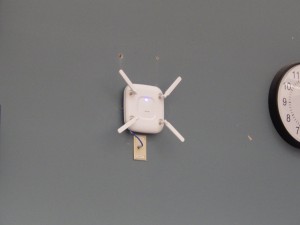Monday, April 27, 2015 by Eli Fisher
In the coming weeks, Saratoga Springs High School will begin allowing students to access the building-wide WiFi network with their own devices, as long as such devices have a screen size of seven inches or larger, according to Instructional Technologist Jody Terry. The network has been expanded over the past year to cover most areas in the building, but until now, only district-owned devices and devices of teachers who have specifically requested access have been able to take advantage of the network.
All student devices on the network must have a screen size of seven inches or more, which includes tablets such as all iPad and iPad mini models, but excludes cell phones, including large-screen smartphones such as the Samsung Galaxy Note and Galaxy Mega. Terry said that phones would place too much strain on the network’s resources if they were allowed to connect to it. In order to enforce the screen size limit, access will be allowed on a device-by-device basis.

Eli Fisher / The Lightning Rod
When asked if and how she would use the network, sophomore Skyler Stanford said she would use it “to check my grades…there’s also games sometimes that you play in class that you have to use data for.” Several students agreed that the network would be useful during class time.
Students Max Sanchez and Savanna Brandt said they had tablets that they would use on the network.
“I’ve got my own tablet, but I can’t use it for anything [at school]”, said Brandt.
English teacher Jill Cowburn said that if significant educational enhancement is provided by use of the network, it might create further inequity between students of different income levels. Those who can’t afford a laptop or tablet won’t benefit from it, at least initially.
One student, Aliya ElSawi, expressed hope that the network would be usable for more devices, and therefore more students, in the future, and thought that many students would continue to use cellular data with their phones rather than acquire tablets.
Cowburn said she would allow tablet and laptop use in her classes by students that had gone through the process for getting on the network.
“I think that typed notes and easier accessibility to class materials will make the learning process more fluid,” said Cowburn. “Typed notes are the norm in college, therefore why not allow students to prepare for that?” She added that typed notes would allow better organization of notes.
There will be several other restrictions placed on student use of the network. Students will be required to complete an online tutorial before they are able to access the network, and each student that wishes to use the network must sign an annual agreement and have a parent sign it as well. After that, they will be able to sign in with their normal school login credentials to connect to the network. Use will be allowed only for educational purposes, and Terry said that the same web filters used on district-owned devices will apply to the network.
“I think that it could be a distractor because I know how distracting phones can be,” said Cowburn, “but like phone policy, a teacher has to enforce the rules.” She agreed that some teachers might not allow network use in class.
Students will not be able to print or access N-drives using the network, at least in its initial phase. The network currently covers all classrooms and indoor areas of the high school except the gymnasiums and the Loewenberg Auditorium.
Do you have an opinion about this article? You can have a voice too. Comment below or tweet us @Lightning_R0d.

Nice article